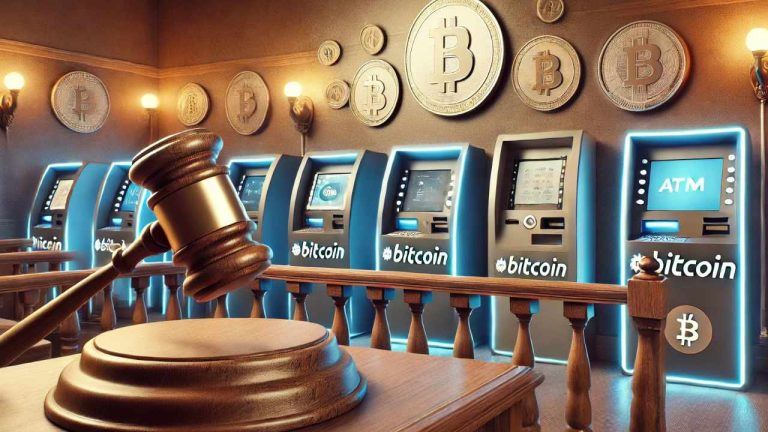 A California Superior Court has upheld the Digital Financial Assets Law, which includes a $1,000 daily withdrawal limit for cryptocurrency ATMs. The law also requires crypto ATM operators to obtain licenses and comply with fee limits and new disclosures. California Court Upholds Bitcoin ATM Withdrawal Limit The California Department of Financial Protection and Innovation (DFPI) […]
A California Superior Court has upheld the Digital Financial Assets Law, which includes a $1,000 daily withdrawal limit for cryptocurrency ATMs. The law also requires crypto ATM operators to obtain licenses and comply with fee limits and new disclosures. California Court Upholds Bitcoin ATM Withdrawal Limit The California Department of Financial Protection and Innovation (DFPI) […]

Coinbase has marked its third consecutive quarter in the black, with its net revenue and trading volumes jumping 108% and 145%, respectively, from the prior year.
Coinbase shares rose 3.2% after hours following its latest Q2 results filing — reporting $1.4 billion in revenue in Q2 along with a hefty year-on-year increase in crypto trading volumes.
The crypto exchange reported $266 million in consumer and institutional trading volumes, up from the prior year period and in line with analyst estimates, though it was a considerable drop from the $312 billion reported in Q1.
When it came to revenue, Coinbase gained the most ground from subscription and services revenue, which includes stablecoin revenue, blockchain rewards and fees. This marked a 17% increase from Q1 and nearly doubling from Q2 2023.
Analysts have called for a U.S. recession all year, but stocks continue to creep higher. Here are three metrics investors can watch to know if an economic downturn is coming.
Inflation came down a lot faster than most investors and analysts anticipated, reaching 3% in June. The recession that most analysts predicted is nowhere to be seen, according to the 3.6% unemployment rate nearing a 50-year low and the S&P 500 Index showing a 19% gain year-to-date.
While the current market performance may lead investors to believe that a recession has been avoided, there are three metrics that have been able to consistently predict recessions over time. These leading economic indicators are key economic variables that tend to move ahead of changes in overall economic activity, providing an early warning system for changes in the business cycle. Let’s dig into three of these indicators and explain how investors can interpret them.
The yield curve represents the relationship between short-term and long-term interest rates on government bonds. Normally, long-term bonds have higher yields than short-term bonds to compensate investors for the risk of holding their money for a more extended period.
Historically, an inverted yield curve has often preceded recessions. This indicator suggests that investors are worried about the near future and expect interest rates to fall due to a potential economic slowdown.

The two-year Treasury yield is currently 3.25%, while the 10-year Treasury yield is 2.95%, typical of periods ahead of a recession. However, that has been the case since September 2022, and historically there’s a nine- to 24-month lag before the economic contraction takes place.
The Conference Board, a nonprofit research organization, compiles a set of economic indicators known as the leading economic indicators (LEI). These indicators include a variety of data points, such as building permits, stock prices, consumer expectations, average weekly hours worked and more.

When these indicators start to decline or show a pattern of negative movement, it can signal an impending recession. The consumer confidence index for July hit a reading of 117, the highest level in two years. Moreover, according to The Conference Board, the probability of a recession in the next six months is 25%, down from 30% in June.
The purchasing managers’ index (PMI) is based on five major indicators: new orders, inventory levels, production, supplier deliveries and the employment environment. A PMI of more than 50 represents an expansion, while readings under 50 represent a contraction. The PMI is seen as a very reliable tool, as it provides timely and accurate data on the manufacturing sector.
The S&P Global U.S. Manufacturing PMI fell to 46.0 in July 2023, down from 46.9 in June and 48.4 in May. This is the lowest reading since December 2022, and it indicates that the manufacturing sector is in a state of contraction. In short, the global economy is slowing down, and this is having a negative impact on demand for exports from the United States.
The U.S. economy is currently presenting mixed signals. Despite a robust consumer demand underpinned by rising wages and low unemployment, industrial growth indicators have remained weak throughout 2023. Moreover, bond markets suggest market reluctance to add risk-on positions.
This hesitancy is due to the Federal Reserve’s anticipated monetary policy tightening and further expected interest rate hikes for 2023. These different signals show the tricky situation for those in charge of the interest rates.
If the Fed tightens policy too much, it could slow down the economy too quickly, possibly leading to a recession. On the other hand, if the Fed is too lenient, it could trigger high inflation, which erodes purchasing power and can destabilize the currency.
Related: Bitcoin price is down, but data signals that $30K and above is the path of least resistance
For cryptocurrency investors, there’s an additional variable that further complicates the analysis. Despite the long-term high correlation between Bitcoin (BTC) and the stock market, the past eight months have displayed periods of inverse trend, meaning the assets moved in distinct directions.

Amid crypto market uncertainty, the Fed’s decisions are key to revealing economic confidence. Increasing interest rates signifies stability, potentially benefiting cryptocurrency markets in the short term, whereas rate cuts may indicate economic concerns, possibly affecting risk-on markets in general. Therefore, tracking the Fed provides timely investor guidance in uncertain economic times.
This article is for general information purposes and is not intended to be and should not be taken as legal or investment advice. The views, thoughts, and opinions expressed here are the author’s alone and do not necessarily reflect or represent the views and opinions of Cointelegraph.
 The annual inflation rate in China has unexpectedly slowed down in March to its lowest level in a year and a half, the latest statistical data indicates. On a monthly basis, consumer prices decreased for a second consecutive month, despite estimates suggesting they will remain unchanged. Post Zero-Covid Policy Inflation in China Eases Further China’s […]
The annual inflation rate in China has unexpectedly slowed down in March to its lowest level in a year and a half, the latest statistical data indicates. On a monthly basis, consumer prices decreased for a second consecutive month, despite estimates suggesting they will remain unchanged. Post Zero-Covid Policy Inflation in China Eases Further China’s […]
The battle for global consumer deposits is going to be the fight of the century. But to vanquish old-fashioned banks, the DeFi sector needs to up its game.
The world runs on consumer spending and consumer saving. It is everyday people who actually power the most important parts of the global economy and the global financial system.
For consumers, this system runs through their retail bank. It is where most people save, spend and pay their taxes. This is the battleground for the coming fight: the battle for global consumer deposits.
Make no mistake, this will be the fight of the century. It will change the shape of the world more fundamentally than the internet has already. The internet was about information. DeFi is about capital — and as we all know, money is power.
Today, most people either hate or are indifferent to their bank. That is probably because they fine you for tiny mistakes, keep you on the phone for hours, give you the worst interest rates imaginable, and provide you with a user experience that borders on hostile.
That is not always the fault of the bank. Consumer regulation and controls have been mounting to the point that compliance is often one of the biggest cost centers for all retail banks. Such institutions cannot innovate because they are built to resist change, not to embrace it.
Decentralized finance has flipped the model on its head, delivering a new world of financial products, built using smart contracts that allow consumers to switch between providers in a matter of seconds, all at the click of a mouse.
Related: DeFi will bring global revolution to the traditional finance space
It is not that the DeFi model is just better — it’s simply fundamentally different. In the old world of retail banking, we had to trust the people that run banks. This trust is expensive. In the new world of decentralized finance, we trust the code that provides our financial services.
Protocols such as Aave, Uniswap and MakerDAO have the ability to directly control assets like USD Coin (USDC), Ether (ETH) and Wrapped Bitcoin (wBTC), enabling the rise of financial products that can operate 24/7, 365 days a year, with 100% uptime and no staff. It removes the cost of checks and balances. It takes handcrafted financial processes and turns them into automated programs.
Decentralized finance gives entrepreneurs an irresistible opportunity to truly compete in the world of global finance — a place that was once the exclusive realm of multinational corporations with eight-figure legal teams on retainer. Not only this, DeFi lowers the switching costs for a consumer to almost zero: I can move my capital from Aave to Compound to Uniswap in a matter of minutes, with precisely zero paperwork.
Related: DeFi-ing the odds: Why DeFi could rebuild trust in financial services
On DeFi, capital can flow almost instantly to the best value opportunities, and it provides the thing that global finance truly needs: real competition and real innovation. This competition is why DeFi will kill the retail bank. If I can get 15% APR in my favorite DeFi savings decentralized application, why would I ever keep my money in a bank?
But right now, all is not well in DeFi. To date, DeFi on Ethereum has seen over $285 million in hacks, rewards are unfairly shared, and Ethereum continues to be congested and expensive to use.
The trust model of DeFi is code, not humans. The community is essential to the success of any ecosystem. To win, a platform must never get congested — no matter how many people are using it.
Related: Smart contract exploits are more ethical than hacking... or not?
We need a decentralized network where developers can build quickly without the constant threat of exploits and hacks, where every improvement will get rewarded, and where scale will never be a bottleneck. Because only then can the retail banks be slain and we get to see what great consumer finance truly looks like.
This article does not contain investment advice or recommendations. Every investment and trading move involves risk, and readers should conduct their own research when making a decision.
The views, thoughts and opinions expressed here are the author’s alone and do not necessarily reflect or represent the views and opinions of Cointelegraph.